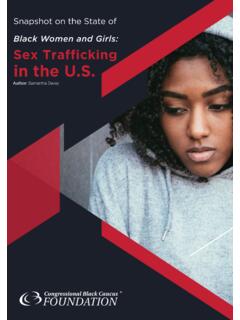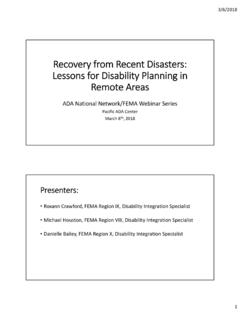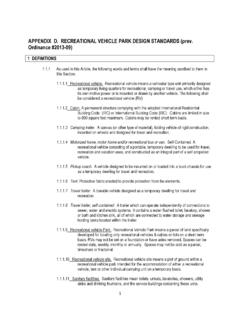Transcription of By Richard EZIKE, Ph.D. - Congressional Black Caucus ...
1 By Richard EZIKE, , Sustainability, and Equity and the Effect on the African-American Community2 Table of COntentsOverviewCONSEQUENCES OF TRANSPORTATIOn INEQUITYT ackling Transportation Inequity by Increasing AccessCase StudiesTHE SHARING ECONOMYR ecommendations// 3// 5// 7// 8// 11// 13 Transportation, Sustainability, and Equity and the Effect on the African-American Community3 Transportation equity has always been an invisible driver of equal opportunity and social change. Lack of access and affordability have long been correlated with race when it comes to African Americans and have historically served the purposes of segregation.
2 It is critical that public policies and state and local efforts address transportation equity and sustainability with an eye towards comprehensive approaches that tackle the socioeconomic and racial disparities that resulted from our past. 1 Transportation in the United States has historically favored middle-class and affluent neighborhoods at the expense of disadvantaged communities, resulting in skewed patterns of infrastructure development in metropolitan areas across the Development has concentrated on highway construction for automobile travel, giving little consideration to sustainable, transit-oriented development (TOD).
3 The dependence on automobiles as the primary mode of transportation in the country has fueled the development of a low-density, sprawl-like pattern which has defined America s large cities. This development resulted in neglect of the central city. Residents living in the city, primarily being low-income people of color, therefore, witnessed their neighborhoods deteriorate over time and problems such as crime and high unemployment increased. Those residents who desired to move away faced challenges in accessing the suburbs where the greatest opportunities for employment were Dr.
4 Menna Demessie, Congressional Black Caucus Foundation, Inc. Quote obtained on March 10, PolicyLink: All Aboard: Making Equity Central in Transportation Planning, 2014. , Sustainability, and Equity and the Effect on the African-American Community4 However, the central neighborhoods of cities are redeveloping at a rapid pace. New residents, who are mostly young and highly educated, are moving back to communities where both work and leisure activities are within walking distance of their home. A negative side-effect of this migration is that low-income residents and residents of color living in the city are eventually forced to leave because they cannot afford rising rent costs.
5 They end up moving to the suburbs and often settle in the most impoverished areas, which are often underdeveloped, suffer from underfunded schools, are located near polluting facilities such as coal-fired power plants, and have streets devoid of sidewalks. Furthermore, the displaced residents are forced to move away from opportunities for employment, good health care, and viable education. Many suburbs, built exclusively for well-off residents with cars, have less-than-developed public transit systems, which many low-income people depend heavily on.
6 Transportation, Sustainability, and Equity and the Effect on the African-American Community5 Research studies illustrate a number of statistics that show how low-income communities of color are negatively impacted by the current transportation infrastructure in the :Figure 1: Race and Income-Based Transportation , Sustainability, and Equity and the Effect on the African-American Community6- Over 70% of regional jobs are now more than 3 miles away from central business districts1 while most low-income people continue to live within the central city;2- Since 2000 - 2010, household income has grown 25%, but the combined costs of housing and transportation have increased 44%.
7 3- Transportation costs are now the second largest expense for most American households, eating up an average 20 cents of every dollar in income and as much as 55 cents for every dollar earned by the poorest households. (High-income 1 Glaeser, Edward. 2001. Decentralized Employ-ment and the Transformation of the American City. Brookings-Wharton Papers on Urban Affairs: Glaeser, Edward L., Matthew E. Kahn, and Jordan Rappaport. 2008. Why do the poor live in cities? The role of public transportation. Journal of Urban Economics 63, no. 1: Partnership for Sustainable Communities, Part-nership for Sustainable Communities: Five Years of Learning from Communities and Coordinating Federal Investments, 2014.)
8 Spend only nine cents for every dollar earned); 4- African Americans suffer a pedestrian fatality rate that is 60 percent higher than non-Hispanic Whites, at per 100,000 persons (age-adjusted);5- African Americans make up percent of the population, but they account for percent of all pedestrian deaths;- Children from low-income families are twice as likely to walk to school than those of higher-income families, and therefore have a higher risk of being injured or killed as PolicyLink: All Aboard: Making Equity Central in Transportation Planning, 2014.
9 Smart Growth America, Dangerous By Design 2014 , 2014, Safe Routes to School National Partnership, Imple-menting Safe Routes to School in Low Income Schools and Communities: A Resource Guide for Volunteers and Professionals, June , Sustainability, and Equity and the Effect on the African-American Community7 Tackling Transportation Inequity by Increasing Access1. Building multimodal transportation facilities (rail stations, bike-sharing stations, bus rapid transit, etc.) located in low-income areas to give residents the ability to move around a city without a car;2.
10 Ensuring a safe, efficient, and easy-to-follow trip when using multimodal transportation (everyone from the preschool student to the elderly should not have difficulty riding and should be safe), and;3. Linking low-income residents with employers, health care access, grocery store locations, and recreational needs which will provide access to jobs, good health, nutritious food, and enjoyable activities that make for high quality living. The CBCF supports policies that promote access to multiple modes of transportation for all people, especially African Americans from lower-income communities.





